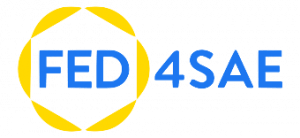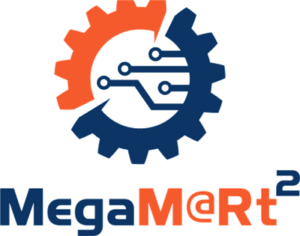EU-Funded Projects
fentISS is in the cutting-edge of the technology and promotes the application of new technologies throughout research activities to develop more efficient, reliable and available solutions. The European Union provides funding for a range of projects and programmes in which fentISS takes part to continue growing the R+D+I scheme.
fentISS has collaborated in several major EU-funded research and innovation projects:
METAMORPHA
The METAMORPHA concept is a single agile USP laser micromachining platform to replace many conventional manufacturing process chains. It has the potential to eliminate thousands of environmentally damaging production processes. METAMORPHA is all-electric, all-digital, produces no waste chemicals and enables novel processes for product rework and repair. All-in-one module: The key to this agility is a combination of two cascaded spatial light modulators (SLM) and a galvo scanner resulting in the most sophisticated beam shaping and steering ever developed. This allows a single module to perform the job of several laser processing heads: e.g. polishing, milling, drilling and cutting (importantly including any wall angle). Made-to-measure laser processes: Each infeed component is scanned with a high resolution 3D sensor. A machine learning algorithm determines an individualised laser process to maximise efficiency and ensure “first time right”. In-line process control: Data from additional online sensors are processed using an edge device running a self-learning algorithm to provide real-time feedback for system control. The ultra-fast edge-based signal processing and synchronisation are key project topics. Agile and scalable: Suitable for any standard industrial production line including 2-, 3- or 5-axis, rotating and roll-to-roll, and for scale up to parallel processing with multiple modules.
HERMES
The HERMES Project borns out from the popularity of Field Programmable Gate Array (FPGA) devices in the space industry. The potential for FPGA use in space is steadily increasing, continuously opening up new application areas and the consortium wanted to reflect this outstanding opportunity through the creation of this project.
HERMES has an essential role in the future of European space programmes, not only supporting the industry competitiveness, but also guaranteeing European technology independence. Being one of the partners, NanoXplore, the unique European provider of high density rad-hard FPGA components, the overall objective of HERMES is to develop the next generation of rad-hard SoC FPGA, porting the XtratuM Next Generation (XNG) Hypervisor from fentISS and qualifying its XNG version at ECSS level B.
XANDAR
The next generation of networked embedded systems (ES) necessitates rapid prototyping and high performance while maintaining key qualities like trustworthiness and safety. However, deployment of safety-critical ES suffers from complex software (SW) toolchains and engineering processes. Moreover, the current trend in autonomous systems relying on Machine Learning (ML) and AI applications in combination with fail-operational requirements renders the Verification and Validation (V&V) of these new systems a challenging endeavor.
XANDAR will deliver a mature SW toolchain (from requirements capture down to the actual code integration on target including V&V) fulfilling the needs of the industry for rapid prototyping of interoperable and autonomous ES. Starting from a model-based system architecture, XANDAR will leverage novel automatic model synthesis and software parallelization techniques to achieve specific non-functional requirements setting the foundation for a novel real-time, safety-, and security- by-Construction (X-by-Construction) paradigm. For the first time, XbC-guided code generation for non-deterministic ML/AI applications will be combined with novel runtime monitors to ensure fail-operation in the presence of runtime faults and security exploitations. The project provides a consortium covering the full spectrum of ES and software engineering. XANDAR will be validated by an automotive OEM (BMW) and the German Aerospace Center (DLR). Leading European SMEs and enterprises such as Vector, AVN, and fentISS as well as successful academic partners will contribute their diverse knowhow in Model-Driven Engineering, Software Systems and V&V, multicore architectures, code generation, and security enforcements from higher-level behavioral models to actual runnables.
De-RISC
De-RISC – Dependable Real-time Infrastructure for Safety-critical Computer – is a project where an international consortium will introduce a hardware and software platform based around the RISC-V standard. The work proposed in this project is to productize a multi-core RISC-V system-on-chip design already owned by Cobham Gaisler and to port the XtratuM hypervisor owned by fentISS to that design, to create a full platform consisting of hardware and software for future European developments within space and aeronautical applications. Barcelona Supercomputing Center – Centro Nacional de Supercomputación will provide its expertise in safety-critical hardware support (monitoring units and contention control) and Thales Research & Technology will provide a representative modular application as a use case.
The goals of De-RISC are:
- Strengthen European leadership in the supply of Integrated Modular Avionics HW/SW.
- Consolidate the European position in real-time embedded processors technology.
- Capitalize on the economy of scale by reinforcing an open standard ISA for the embedded market.
The coordination of the project is carried out by fentISS.
TIME4PS
The main goal of the project is to provide a complete set of tools that covers all the phases of the life cycle of the product: from the system design to the final configuration file of the partitioned system.
The goals of Time4PS are:
Connect our customers modelling tool with Time4Sys.
Give Time4Sys the ability to define partitioned systems.
Connect Time4Sys and Xamber so the timing performance verification is automatically done in Xamber.
Demonstrate de capabilities of the partitioned framework developed by means of an application experiment in the space domain.
In the architecture proposal, three tools are connected to define the complete system: a modelling design tool (EEI/XPM) that is used to model the system and generate the deployment and automatic code of the applications, Time4sys to define temporal information, and a configuration tool to obtain the static configuration file for XtratuM (Xamber).
Time4PS will contribute to scientific progress of software engineering for mixed criticality embedded real-time systems and it will highlight the increase in quality and effort savings obtained by using an integrated software development lifecycle supported by the appropriate tools. The close interaction of fentISS with FED4SAE partners, notably the Thales Group research team, will enhance the project impact in the scientific community.
MegaM@Rt2
European industry faces stiff competition on the global arena. The electronic systems become more and more complex and call for modern engineering practices to tackle productivity and quality. The model-driven technologies promise significant productivity gains, which have been proven in several studies. However, these technologies need more development to scale for real-life industrial projects and provide advantages in runtime. MegaM@Rt brings the model-driven engineering to the next level in order to help European industry to reduce development and maintenance costs as well as to reinforce productivity and quality. The overall approach of MegaM@Rt is to scale up the use of model-based techniques by offering proper methods and related tooling interacting between both design time and runtime, as well as to validate the designed and developed approach in concrete industrial cases involving complex systems. Thanks to the model-based method, different systems will be able to communicate through the entire development chain, and moreover it will be possible for systems in operation to feed back the collected data for continued development.
MegaM@Rt will strengthen European scientific and technical leadership in the development of complex systems. MegaM@Rt targets the following main impact objectives:
- Significantly increased productivity and quality of system development and shorten time-to-market for complex systems.
- Reinforced European scientific and technological leadership in the design of complex systems.
- Improved competitiveness of European companies that rely on the design and integration of complex systems in their products by reducing design and maintenance costs as well as the time-to-market.
This project is part of the MegaMart2 ECSEL-JU.
Safepower
fentISS is participating in the European H2020 SAFEPOWER project. SAFEPOWER has received funding from the European Union’s Horizon 2020 research and innovation programme under grant agreement Nº 687902.
SAFEPOWER’s goal is to enable the development of low power mixed-criticality systems through the provision of a reference architecture, platforms and tools to facilitate the development, testing, and validation of these kinds of systems according to the market needs.
It is expected that the SAFEPOWER reference architecture and platforms will enable the integration and partitioning of mixed-criticality applications on a single device while reducing the total power consumption by 50%, compared to the non-integrated multi-chip implementation.
To address this goal, SAFEPOWER needs to address a number of technology development challenges, that will afterwards be applied to the main project outputs, namely the SAFEPOWER low power reference architecture, the platforms and tools for the development, testing, and validation of low power mixed criticality systems.
EuroCPS
fentISS participated in one of the supported projects (EuroCPS01-014) related to the Avionics Platform jointly with the Thales Group. CEA was the coordinator of EUROCPS project.
EuroCPS was an European funded project gathering several design centers in order to boost and initiate synergies between innovative companies, major CPS-platforms and CPS-competency providers. The motivation of the project was to enable companies making new CPS products to get access to leading edge technology platforms from large companies and support from competency partners. The outcome was to boost and sustain the demand for local manufacturing and catch the IoT market by improving the European competitiveness. The first goal was to bring innovative CPS to business from any sectors within the help of networking partners. The second goal was to link user and supplier across value-chains and region within the help of the competence partners (coaching, development plan definition, service providers). Support, management and monitoring were provided by the cascade funding partners coming from RTOs and technology transfer-oriented university institutes.
DREAMS
The objective of DREAMS was to develop a cross-domain architecture and design tools for networked complex systems where application subsystems of different criticality, executing on networked multi-core chips, are supported.
DREAMS delivered architectural concepts, meta-models, virtualization technologies, model-driven development methods, tools, adaptation strategies and validation, verification and certification methods for the seamless integration of mixed-criticality to establish security, safety, real-time performance as well as data, energy and system integrity.
The ambitious goals of the project were supported by 16 project partners distributed across six European countries. The project partners included major European companies encompassing large enterprises (Alstom, STMicroelectronics, Thales, TÜV Rheinland) and SMEs (fentISS, RealTime-at-Work, TTTech, Virtual Open Systems,). Furthermore leading universities and research institutes (FORTISS, IKERLAN, ONERA, Polytechnic University of Valencia, SINTEF, Technological Educational Institute of Crete, Technical University of Kaiserslautern and University of Siegen) contribute to DREAMS.
DREAMS project was coordinated by University of Siegen (Germany).

MultiPARTES
MultiPARTES is supported by the European Union under the 7th Framework Programme in the area of Information and Communication Technologies (ICT).
Modern embedded applications typically integrate a multitude of functionalities with potentially different criticality levels into a single system. Without appropriate preconditions, the integration of mixed-criticality subsystems can lead to a significant and potentially unacceptable increase of engineering and certification costs. A promising solution is to incorporate mechanisms that establish multiple partitions with strict temporal and spatial separation between the individual partitions. In this approach, subsystems with different levels of criticality can be placed in different partitions and can be verified and validated in isolation. The MultiPARTES FP7 project aims at supporting mixed-criticality integration for embedded systems based on virtualization techniques for heterogeneous multicore processors. A major outcome of the project is the MultiPARTES XtratuM, an open source hypervisor designed as a generic virtualization layer for heterogeneous multicore. MultiPARTES evaluates the developed technology through selected use cases from the offshore wind power, space, visual surveillance, and automotive domains.

VOS4ES
VOS4ES is supported by the European Union under the 7th Framework Programme in the area of Information and Communication Technologies (ICT).
The use of embedded systems is nowadays spreading at an increasing speed, to all aspects of modern life as well as all phases of industrial production. Their use extends from everyday non-critical or soft real-time consumer electronics and telecommunications equipment, to highly critical automotive, railway, automation control and aerospace systems, which satisfy the most stringent real-time constraints. Regardless of the application criticality, however, the need for high integrity and high availability systems as well as for systems that handle their data in a secure way is common and solutions demanding.
In order to follow these technology tendencies, there is a growing interest in enabling multiple critical applications to share a single processor and memory with non-critical and of different security level ones. Partitioned software architectures seem to be the future of secure systems. They have evolved to fulfill security and highly critical real-time systems requirements where predictability is an extremely important factor.
The significant technological know-how and the high cost required for using virtualization technologies has prevented European SMEs which develop embedded systems, from adopting these advanced technologies and exploiting the competitive advantages of the existing virtualization solutions and especially secure partitioning techniques in their systems. The VOS4ES goal is to provide a highly extendible, open source virtualization layer and a set of supporting toolsthat will allow SMEs to have access to virtualization technologies at a low cost and with high flexibility concerning its adaptation to specific requirements as opposed to existing proprietary solutions.

Oversee
OVERSEE is a European research project funded within the 7th Framework Programme of the European Commission.
The overall goal of OVERSEE is to contribute to the efficiency and safety of road transport by developing the OVERSEE platform, which will provide a secure, standardized and generic communication and application platform for vehicles.
OVERSEE is the acronym for Open VEhiculaR SEcurE platform. You are invited to find all the information on the proposed platform and why this platform will be open and secure on this website. We would be glad if you would like to follow up the project’s process. Please feel free to contact us if you have further questions concerning the OVERSEE project.
One of the results of the project is the virtualisation layer based on XtratuM.









